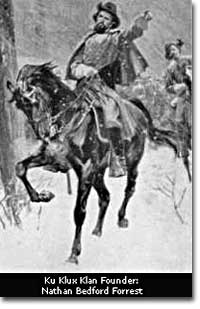

Andrew Johnson was the only Southern Senator to remain loyal to the Union during the Civil War. As a reward, the pro-war Southern Democrat was appointed as military governor of Tennessee, and later asked to join Abraham Lincoln's ticket as vice-presidential candidate.
Reconstruction refers to the period following the Civil War of rebuilding the United States. It was a time of great pain and endless questions. On what terms would the Confederacy be allowed back into the Union? Who would establish the terms, Congress or the President? What was to be the place of freed blacks in the South? Did Abolition mean that black men would now enjoy the same status as white men? What was to be done with the Confederate leaders, who were seen as traitors by many in the North?
Although the military conflict had ended, Reconstruction was in many ways still a war. This important struggle was waged by radical northerners who wanted to punish the South and Southerners who desperately wanted to preserve their way of life.

African American soldiers mustered out at Little Rock, Arkansas
Alfred Rudolph Waud
Published in: Harper's Weekly May 19,1866
Archived at the Library of Congress
This drawing of African American soldiers returning to their families in Little Rock, Arkansas, after the war captures the exhuberant spirit of many former slaves upon gaining their freedom. They were soon to find out that freedom did not necessarily mean equality.
Slavery, in practical terms, died with the end of the Civil War. Three Constitutional amendments altered the nature of African-American rights. The Thirteenth Amendment formally abolished slavery in all states and territories. The Fourteenth Amendment prohibited states from depriving any male citizen of equal protection under the law, regardless of race. The Fifteenth Amendment granted the right to vote to African-American males. Ratification of these amendments became a requirement for Southern states to be readmitted into the Union. Although these measures were positive steps toward racial equality, their enforcement proved extremely difficult.
The period of Presidential Reconstruction lasted from 1865 to 1867. Andrew Johnson, as Lincoln's successor, proposed a very lenient policy toward the South. He pardoned most Southern whites, appointed provisional governors and outlined steps for the creation of new state governments. Johnson felt that each state government could best decide how they wanted blacks to be treated. Many in the North were infuriated that the South would be returning their former Confederate leaders to power. They were also alarmed by Southern adoption of Black Codes that sought to maintain white supremacy. Recently freed blacks found the postwar South very similar to the prewar South.

The Ku Klux Klan was co-founded by former Confederate cavalry general, Nathan Bedford Forrest. He later tried to disband the group when they became too violent.
The Congressional elections of 1866 brought Radical Republicans to power. They wanted to punish the South, and to prevent the ruling class from continuing in power. They passed the Military Reconstruction Acts of 1867 , which divided the South into five military districts and outlined how the new governments would be designed. Under federal bayonets, blacks, including those who had recently been freed, received the right to vote, hold political offices, and become judges and police chiefs. They held positions that formerly belonged to Southern Democrats. Many in the South were aghast. President Johnson vetoed all the Radical initiatives, but Congress overrode him each time. It was the Radical Republicans who impeached President Johnson in 1868. The Senate, by a single vote, failed to convict him, but his power to hinder radical reform was diminished.
Not all supported the Radical Republicans. Many Southern whites could not accept the idea that former slaves could not only vote but hold office. It was in this era that the Ku Klux Klan was born. A reign of terror was aimed both at local Republican leaders as well as at blacks seeking to assert their new political rights. Beatings, lynchings, and massacres, were all in a night's work for the clandestine Klan. Unable to protect themselves, Southern blacks and Republicans looked to Washington for protection. After ten years, Congress and the radicals grew weary of federal involvement in the South. The withdrawal of Union troops in 1877 brought renewed attempts to strip African-Americans of their newly acquired rights.
Freedmen's Bureau
In the years following the Civil War, the Bureau of Refugees, Freedmen, and Abandoned Lands (the Freedmen's Bureau) provided assistance to tens of thousands of former slaves and impoverished whites in the Southern States and the District of Columbia.
Nast's Johnson as Iago
Andrew Johnson is portrayed by cartoonist Thomas Nast as the Shakespeare villain Iago. A suspicious black Union veteran is Othello. Johnson claims that "Treason is a crime and must be made odious" and "I am your Moses," but around them swirl riots and mayhem.